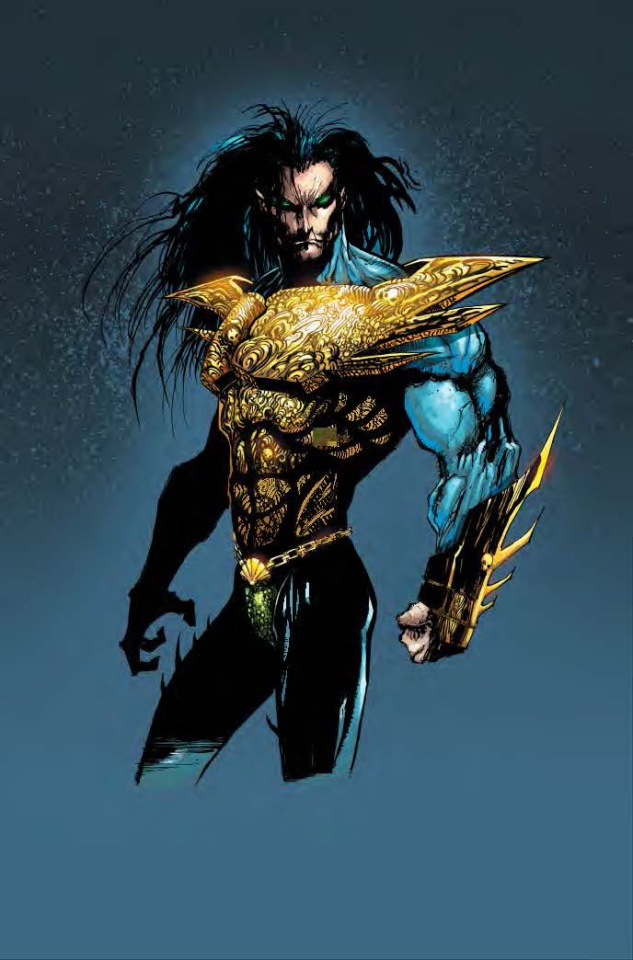He's definitely another of my favorite of the crazy 90's comic artists, standing along side Mark Texeira (who I talk about all the time). The 90's were the decade when everything had to be extreme, and these guys were as extreme as it gets.
 |
| In this drawing of the character Chapel you can see a strong Simon Bisley influence |
Unlike Texeira though, when I look at Jae Lee's work, I don't see distorted bodies so much as the pure essence of these characters. It's like you're seeing their spirits or thri souls, rendered symbolically to show you the intense energies raging inside of them. The narrator in the video mentioned they look like demonic mosters, and that's definitely true. In the 90s comics followed where movies and pro wrestling had led, away from good-guy heroes, through antiheroes, and into a space where there are no heroes anymore, or rather you can't tell them from the bad guys. They're monsters. They had all become monsters. And in comics like those of Jae Lee and Mark Texeria even the 'good guys' are violent and destructive. It's just that they only unleash it against the really tyrannical sadistic monsters that are the bad guys. I think the idea was "It takes a monster to fight a monster." That concept has always been there, if often subdued, in stories involving heroes and villains.
This kind of art (in which I include both Jae Lee and Mark Texeira) could only happen in a post-Frank Miller, post Sienkiewicz, post Walt Simonson world—those guys I spoke about recently who had to restrain themselves through the seventies and part of the 80's and were finally freed to do the more powerful, modernistic, and exaggerated art they had always wanted to do. That laid the ground work and allowed for the next generation to push beyond, culminating as far as I'm concerned with Jae Lee and his crazy explosion of pure raging testosterone-fueled expressionist nightmare imagery.
This kind of art and this whole business model for comics topped out and apparently burned out somewhere in the mid to late 90's. I can't really say what happened, I lost interest around that time and stopped looking at comics. The last thing I remember buying in a comic shop was the 4-issue Sabretooth miniseries drawn by Texeira that I posted about recently. I don't think I even went back into a shop after that. I can't say exactly why, I think it was burnout or too much extremism. They had pushed it all so far it became too much. You can't just keep going in such a crazy destructive direction, and how do you come back down from it? I don't know how they did it, I just know everybody seemed to lose interest in this over-the-top stuff around the same time. Maybe the times they were a-changin'.
Maybe the artists couldn't sustain that kind of intensity and extreme distortion for very long. Nor could the readers. Extremism tops out and fades, or it explodes and then people have to start to rebuild from the ashes. The few times I tentatively peeked in at what new comics looked like afterwards (years later) I didn't like what I saw. No more extremism, no more testosterone-fueled monsters raging at each other looking like inflated bodybuilders on steroids or Asian demon spirits. Drawing styles were either uninterestingly realistic or insipidly cartoonish, often with a strong Manga/Anime feel. And when I wanted to see some comic book greatness I had to pull old issues out of the boxes or look up videos about comics from the 70s, 80s and 90s. Or more recently buy Omnibuses or new collections in paperback form of old runs, usually printed on nice slick paper with reproduction values far better than they were originally printed with (on that crappy newprint stock).
His backgrounds were often non-eistent, which makes the comics 'read' very fast—you can quickly see at a glance what's happening, and it helps your eye move around the page rapidly. And when he did draw backgrounds they were even less realistic thean the characters. They were pure expressionism, like something form The Cabinet of Doctor Caligari or Metropolis.




No comments:
Post a Comment